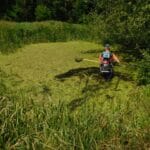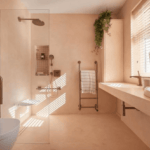If a patient’s body isn’t properly supported while lying in bed or seated in a chair, there are bony parts at risk for pressure ulcers. Poor flow of blood to the the tissue in that area will eventually lead to tissue damage. Normally the sensation will be uncomfortable and will trigger the patient’s desire to reposition the body so that pressure relief is achieved. If a patient has a reduced ability to feel pain and/or cannot move independently, then continuous pressure on that area can and will rapidly cause damage to the skin and deeply into the soft tissues. The outcome is a pressure ulcer.
Utilizing support surface for patients who have been predetermined as a pressure ulcer (PU) risk is the most commonly utilized preventative safety measures for patients. These surfaces can include pressure-relief mattresses, chairs, cushions, foot (more specifically) heel protection, or any other device that is used to offload the pressure from the risk area.
Practitioners on every level should be able to recognize any factors that may be linked to a change in support surfaces. Additionally, they need to recognize when the patient should be supervised with seating and moving and have a precise plan on how it should be done, ensuring that it is done properly. Risk assessments should be performed on a routine basis. The clinician should be able to explain in a concise manner the role that supportive surfaces and equipment play and how much they can provide positively toward the patient’s independence while still managing the risk of PU developing. Make referrals for the patient as an advocate getting them involved with team members of specialists through their journey as a patient (physical therapy, etc).
When considering what support a patient would benefit most from, you should follow the guidelines your employer has in place. Each patient should be individualized in treatment and in risk prevention.
Factors to Consider When Choosing Patient Support:
- Is the patient mobile? Is his/her level of activity high or low?
- Be sure to manage the temperature and the humidity that lies between the patient and the surface. Also control shear force.
- What is the patient’s height and weight?
- Is there an existing PU?
- What is the level of risk for the patient for having additional PUs?
- Make the determination utilizing both a formal risk assessment and clinical judgment.
When equipment is being selected, the nurse should also take into consideration:
- Will the equipment help the patient maintain independence?
- What will the equipment’s impact on manual handling be?
- Does the equipment increase a fall risk?
The patient’s comfort is of the utmost importance. Even if equipment is in optimal working order, if the surface is uncomfortable then the patient will see it as a negative influence on his/her daily being. The patient will then likely reject using it either overtly or when away from the medical eyes. Be sure that the instructions from the manufacturer are closely adhered to and that the equipment is maintained and cleaned on a regular basis.
The Mattress Make a Difference
Patients who have been confirmed to not be a high risk for PU can sleep safely in a high-specification mattress made from foam. If the patient has an existing PU, a support surface must be used no matter what their risk score maybe, but specifically if:
- the patient can’t be positioned in a way that the load is off the PU.
- The patient has PU on two or more of the turning surfaces which limit the options for repositioning.
- The patient is failing to heal or the PU beginning to deteriorate even though the proper comprehensive care has been given.
- The patient is at a high risk of additional ulcers.
- If the patient has had flap surgery or a graft procedure. Perfusion loss in the area will compromise the integrity of the flap or graft.
- The patient is uncomfortable
- If the patient is too big for the current support surface, he/she will bottom out because the body weight cannot be lifted by the current surface.
Speaking on a broad perspective, equipment will work by spreading the pressure out or relieve the pressure all-together. Pressure relieving surfaces (alternating mattresses and cushions) apply and remove pressure intermittently. Pressure is relieved from the affected area where the deflated cell is and pushes magnified pressure to the area where cell inflation needs to be. Some patients find this to be extremely uncomfortable because it tends to give the sensation of being seasick.
The Relief of Pressure-redistribution
Surfaces that redistribute the pressure across the patient’s body increase the contact of the body on the surface and can be constructed of many various materials such as air, foam, gel, or even a combination of the three. High specification mattresses are beneficial for patients that are at a low risk. Flotation systems are recommended for patients that are at a high risk for a PU.
Seating is Important
Seating is just as important as having a good mattress. A proper supportive seat provides a smaller surface area that will support the patient’s weight. A patient that requires a redistributing mattress that spends time not in bed should have at the very least a special cushion that directs the pressure away from the area at risk for a PU when they are seated.
When going over the options for a seating solution it’s urgent that both the chair and the cushion be taken into consideration. The two components may be available as one unit or they may be sold separately. If sold separately, it’s of utmost importance that they work together seamlessly. The provision of the right seating for a patient can be clinically challenging. The ideal seating serves many purposes such as:
- Good seating should help the patient maintain functional posture.
- If the seating is proper, not only will it promote physiological processes such as breathing, but it will improve the processes.
- There should be no increase in the risk to the patient. He/she should be safe from PU and/or falls.
- Good seating should provide the maintenance, promotion, and improvement of independence for the patient.
- The patient should be comfortable when seated. A good supportive seating will not cause discomfort to the patient.
- The levels of the patient’s fatigue should decrease.
- Good supportive seating can be used in many places, not just in the home. The accommodation should work at the job place, in the hospital, or while traveling.
- The most important factor is that the patient should like to use the accommodation.
Making sure that the seating is a right fit for the patient can work toward reducing the risk of PUs and falls while simultaneously promoting good posture and keeping the patient comfortable. Patients should not feel traumatized at the thought of moving from the bed to a chair. It should be a smoothly positive action that doesn’t cause any harm. Time spent seated should be limited until the patient’s tolerance to the additional strain is built up.
There’s always a myriad of patient needs in various environmental settings such as hospitals and skilled nursing facilities. Seating should be effective from a clinical standpoint, but also easy for the patient to use and meet their approval.
Specifications for a Good Seating Fit
- Seat Width– There should be at least 25 mm space between the hip of the patient and the chair side.
- Seat Height– Your patient should be able to put their feet comfortably on the floor.
- Seat Depth– There should be at least 25 mm from the front edge of the seat to the back of the patient’s knees.
- Armrest Height– The armrest needs to support the bent elbow.
- Backrest Height– The backrest must be high enough to give the patient’s back good support.
Devices Used to Prevent PUs on the Heels
There are a variety of devices that will protect the heel in order to prevent PUs from occurring. The damage that can afflict a patient’s heels can range from hypermobility to immobility of a high severity.
This needs to be a consideration when choosing a heel device that is appropriate for the patient.
- Device type: sections of specialized mattress:
- Mechanism of Action:
- Castellated foam allows for greater immersion and envelopment.
- If the heel section is lowered with the calf supported it will allow for easier offloading and/or flotation.
- Advantages:
- Prevention is in the positioning, therefore additional devices are not needed.
- Disadvantages:
- This is only a suitable surface if the patient’s heels sit in the specific section of the mattress.
- Advantages:
- Mechanism of Action:
- Device type: boot:
- Mechanism of Action:
- Offers physical support of the leg off the bed, providing flotation for the heel
- Advantages:
- protection of the entire foot
- pressure is taken off the heel
- protection of the Achilles
- only device that can provide complete offloading
- Disadvantages:
- Boots can prove to be costly.
- There is a risk of deep vein thrombosis when a boot is used.
- Patients often complain that the boot is too hot, and thus they do not wear it as often as it needs to be worn to be therapeutic.
- The boot tends to be large and somewhat heavy, so some customers complain that it hinders their mobility and independence.
- There is an increased fall risk because of the bulkiness of the boot if the patient has poor balance.
- Has resulted in hyperextension of the knee in some patients.
- Advantages:
- Offers physical support of the leg off the bed, providing flotation for the heel
- Mechanism of Action:
- Device type: Pillow:
- Mechanism of Action:
- A normal bed or sofa pillow can be utilized to support the leg off of the bed, providing flotation.
- Advantages:
- Pillows are easily accessible.
- Pillows are meant to be comfortable.
- They are not expensive to purchase.
- Pillows allow the caregiver and practitioner easy visibility to assess the heel.
- Pedal pulses can easily be measured if the leg is propped by a pillow.
- Disadvantages:
- Pillows can be hard to get for more than their intended purpose if in a hospital or skilled nursing facility setting.
- If the pillow is a poorly made pillow, the material on the inside may break down and the heel will be left still pressing on the bed.
- It’s very easy to use a pillow the wrong way.
- Advantages:
- A normal bed or sofa pillow can be utilized to support the leg off of the bed, providing flotation.
- Mechanism of Action:
- Device Type: Wedge:
- Mechanism of Action:
- A wedge serves to physically support the leg off the bed to provide flotation for the heel.
- Advantages:
- Allows the leg to move without having to be removed from the offloading device. The leg can move with no pressure being placed upon the heel.
- Good visibility of the heel is easy when a wedge is used.
- Pedal pulses can be measured easily.
- Disadvantages:
- Wedges are not always readily available.
- A wedge can easily be kicked off of the bed or moved into a position that is not appropriate placement for offloading.
- Advantages:
- A wedge serves to physically support the leg off the bed to provide flotation for the heel.
- Mechanism of Action:
- Device Type: Contact Cast:
- Mechanism of Action:
- Redistribution of pressure
- Advantages:
- Maximizes pressure-redistribution
- Disadvantages:
- This is a technique used by specialists and is not always available.
- Advantages:
- Redistribution of pressure
- Mechanism of Action:
- Device Type: Silicone Heel Cup:
- Mechanism of Action:
- The heel cup redistributes pressure thus reducing the risk for shear force damage to be done to the heel.
- Advantages:
- The heel cup is easy for the patient to use and most patient’s find it to be a comfortable accommodation.
- Disadvantages:
- Can easily be lost in bed linen.
- Can require extra measures to keep the device secure.
- Advantages:
- The heel cup redistributes pressure thus reducing the risk for shear force damage to be done to the heel.
- Mechanism of Action:
- Device Type: Low-friction bootee:
- Mechanism of Action:
- The bootee serves as a reduction of friction that can lead to shear force damage to the heel.
- Advantages:
- The bootee is comfortable and very easy for the patient to use.
- Disadvantages:
- The fall risk is increased if the bootee is left on while mobilizing.
- Advantages:
- The bootee serves as a reduction of friction that can lead to shear force damage to the heel.
- Mechanism of Action:
- Device Type: Multi-layer dressing:
- Mechanism of Action:
- The multi-layer dressing provides for a number of benefits:
- pressure reduction
- shear and friction reduction
- microclimate management
- Advantages:
- Frequently patients do not even realize the dressing is there.
- Battles multiple issues at once (friction, shear, microclimate management, and pressure redistribution)
- Moisture control
- Serves as risk prevention during movement of patient
- long-term cost reduction
- If applied correctly, dressing will stay in position.
- Easily applied and provides for easy inspection.
- Disadvantages:
- If a patient is agitated, it can be difficult to apply and difficult to keep in place.
- Dressing alone will not work, needs adhesive.
- Time consuming in application
- Area of protection is small
- If dressing falls off while the patient is in bed and does not realize it has come loose, this can increase the risk of a PU.
- Advantages:
- The multi-layer dressing provides for a number of benefits:
- Mechanism of Action:
When choosing a surface, the patient’s activity over a 24-hour period needs to be taken into consideration. The patient’s comfort is of utmost importance. If the patient isn’t comfortable, he/she will be unlikely to be compliant with the usage instructions.
ABOUT THE AUTHOR
Heidi West is a medical writer for Vohra Wound Physicians, a national wound care physician group. She writes about healthcare and technology in the medical industry.
Senior Outlook Today is your go-to source for information, inspiration, and connection as you navigate the later years of life. Our team of experts and writers is dedicated to providing relevant and engaging content for seniors, covering topics such as health and wellness, finances, technology and travel.





